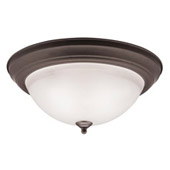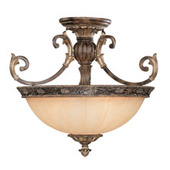
Close-to-Ceiling Light Fixtures
Close-to-Ceiling Light Fixture Size by Width
Close-to-Ceiling Light Fixture Styles
Close-to-Ceiling Light Fixture Finishes
About Close-to-Ceiling Lights
There are two primary types of close-to-ceiling light fixtures: flush mounted and semi-flush mounted. Either will supply general illumination to a room but each have slightly different effects in lighting. In some cases, like in homes built in the mid-20th century, a ceiling fixture is the only light in a room. Whether to use flush or semi-flush lights depends upon the end function. Semi-flush brightens a room more because light not only comes out of the bottom but also shines upwards, and is reflected much more off the ceiling. However, flush mounts have a shorter height and are suitable for lower ceilings.
Ceiling fixtures are a good solution for utilitarian needs, providing general lighting for smaller areas like hallways, bathrooms, laundry rooms, kitchens, and bedrooms. In bathrooms, you would want additional fixtures such as vanity lights or sconces, to provide enough light for grooming. A bedroom could function alright with just a ceiling light but the addition of table lamps for reading is helpful. Kitchens need lots of light, and flush mounts are a popular option over the sink or in a large pantry. Laundry rooms are fine with just ceiling mounted fixtures--a click of the wall switch and you're ready to go.
Gauge what size of fixture you need by the size of the room. Large or longer rooms may require multiple fixtures. Sizes range from 11 inches in diameter to 48 inches or more. The small ones can take one bulb and be perfect for a closet. The large elaborate ones take many bulbs and could be appropriate for a hotel ballroom.
The most common ceiling fixtures are round or square since that is the type that most people recognize, but there are other shapes of close-to-ceiling fixtures. One type is the familiar rectangular or linear fluorescent fixture. These typically take one or two bulbs and can range from 18 to 52 inches in length. These are usually not decorative, but highly useful in certain locations. Fluorescent light is bright, energy-efficient, and evenly spreads around a room minimizing shadows. That is why it is widely used in offices and businesses and makes sense to use in home laundry rooms and garages.
Traditional style ceiling lights quite often have dark bronze or brown finishes (sometimes gold) with beige or amber glass. Ornaments can be curvy and decorative, especially on semi flush ones. Flush mounted fixtures are more plain. Sometimes the glass is ribbed or textured and frequently there are metal embellishments to the fixture of a contrasting finish.
Contemporary ceiling fixtures have chrome, nickel, polished steel, or black finishes often paired with white glass. Some have brightly colored blown glass shades. Straight-sides drum shapes gives a more modern feel than bowl shapes and sometimes a freeform abstract shape is used. Geometrics such as cones, cylinders, rectangles, and spheres are part of contemporary ceiling light designs.
Crystal close-to-ceiling lights are extraordinary and can be the highlight of a room. They may look like truncated chandeliers that hug the ceiling or the crystals can be colored and mixed with other materials, like seashells, to create unique effects. Strands of different length crystals can hang from a flush-mounted pan to make a waterfall of light. Or they can form the sides and bottom of a flush-mounted crystal box, brilliant when lit. Flowers and leaves of crystal decorate casual style ceiling lights with sparkly whimsy.
Some of the most fun ceiling lights are the novelty ones, especially for children's rooms. They can take the form of planes, trains, leaping dolphins, and different kinds of sports. Another style is rustic--these feature north woods animals in natural settings, pinecones, cowboy themes, and fishing scenes. The materials used are often amber mica with brown metal finishes and some art glass for lake and sky areas.


